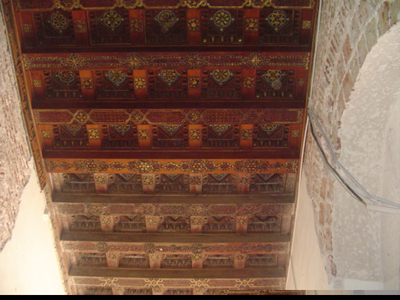
by Mohammed al-Qiri, Yemen Observer, April 8, 2008
The Grand Mosque of Sana’a is considered to be the oldest in the Islamic world. It was built by order of the Prophet Mohamed (PBUH) in the sixth Hijri year, corresponding to 627 C.E.. It is located in the Bathan garden, between Ghamdan palace and the Malmlamah rock.
Over the course of history, there have been many additions made to the original building. The mosque was extended in the eighth century by the Amawi Khalif al-Walid ibn Abdulmalik (705- 715 C.E.) and at the beginning of the Abasi dynasty in the eighth century C.E., doors were added by Governor Omar ibn Abdulmajeed al-A’dawi, in addition to other overhauls in 745 C.E under his watch.
Following some of the flash floods at the end of ninth and the beginning of the tenth centuries, in 878-879 C.E., Ibrahim ibn Mohammed ibn Ya’furi reconstructed the mosque.
Other renovations were also carried out following partial destruction by Ali ibn al-Fadhl in 911-912 C.E., when only the western minaret existed.
The mosque was renovated again by al-Hassan Ibn Salama at the beginning of the 11th century, and at the beginning of the 12th century, Queen Arwa Bint Ahmed al-Sulihi added the famous eastern portico.
The Ibobians renovated the two minarets at the beginning and the middle of the 13th century, and in 1229 C.E., Judge Sarai ibn Ibrahim built the baths as places of ablution.
Omar Ibn Saad al-Rabie’ rebuilt the mihrab in 1267 and Imam Salahdien al-Nasser, renovated the baths and the pool. The western wall was built by the Taharites and at the end of the 16th century, Murad, the Ottoman governor overhauled the Mihrab.
The Ottoman governor Sinan Pasha, at the beginning of the 17th century, rebuilt the Zait tomb and the mosque’s court yard.
At the beginning of the 20th century, Imam Yahiya built the library and a number of posts were added all along the south court yard on the Mihrab side as part of this project, in addition to strengthening the roofs of the eastern and western porticos. At the end of the 20th century, part of the western and northern walls were overhauled, and the mosque’s floors were covered with mosaics. However, in the early seventies the court yard’s floor was changed and the endowment built a library in the mid-1980’s
Recently the mosque was overhauled for the first time on scientific basis at the hands of local and foreign experts.
Engineer Esam Awadh, spoke of the grand mosque’s overhaul, saying that the studies and execution started two years ago, adding that the overhaul will include work on all the walls, the floor, the electricity, yet the focus will be on the colored wooden roof whose area is approximately 300 square meters.
Awadh explained that the work is divided into five stages, each taking five years, ensuring material is imported to replace the old electricity network. The old floor will also be replaced to suit this unique building.
He also added that the mosque will be open for prayer during the overhaul works, as it was a large concern for those who regularly pray at the mosque.
In an inquiry regarding the treatment of the wood works and the Quranic scripts and whether they are going to be removed, he said that these wood works and verses were not touched, even for cleaning purposes for over hundred of years. He assured that they are now being cautiously treated, in order to remove the soot and dust, without damaging them. Other delicate operations and repairs include a small amount of rain moisture damage to the imported teak and tanb woods.
New baths are being built in order to replace the old ones and to avoid the damage from moisture.
While doing the work to the mosque, some old documents were discovered and a committee was formed to hand them over to the manuscript administration to be accessible by researchers.
The donors for the renovation, which costs $6-7 million, are the Social Care Fund and the Arab Development Fund, whose manager recently paid his second visit to the site. He also mentioned the Venice based institute, which aims at spreading cultural renovation awareness and had previous experience in the Jerusalem al-Aqsa mosque renovation.
In another statement, Esam warned that there are people who are joining in the mosque renovation looking for treasures, reiterating that the excavations done now are aiming at checking the soundness of the mosque’s basements and the acknowledgment of the history of the mosque.